Marjorie Fast and Peter Teichroeb Part 2: Peter's Story (1929)
Peter's Story
Copyright 2021 by Janice Teichroeb and Barry Teichroeb. All rights reserved.
This is the second in a series of four biographical accounts chronicling the experiences of Marjorie (Fast) Teichroeb and Peter Teichroeb growing up on the Prairies in the early to mid 1900’s. Interviews were conducted with Pete and Marj during the summer of 2021.
Peter Daniel Teichroeb
Born 3 August 1929, Warman, Saskatchewan, Canada
Peter’s grandparents, Peter Teichroeb and Agatha Dyck, were prosperous landowners and farmers in South Russia at the turn of the last century. Their sizable farming operation employed many laborers, Mennonite and Ukrainian. Grandfather Peter, like his father Daniel, resisted the pressure to join the Mennonite migrations of the 1870s and 1890s that saw so many Russian Mennonites leave for Canada to achieve their dreams of religious, economic, and social freedom and exemption from military obligations. For the Teichroebs life was good in Russia and the socio-political demands were not so onerous. The Great War changed everything.
In the decades before the war the feudal system that had somehow survived in Russia so much longer than anywhere else, was finally abandoned and peasants were granted freedom from indentured service and the ability to own small plots of land. This change was slow to cause any appreciable improvement in the living standards of the common people, but it laid the foundation for a change in attitudes and aspirations. The presumption that poverty was their only destiny was replaced by the demand for a greater share of the wealth and influence they saw jealously guarded by the landholding elites among them, including wealthy Mennonites. World War I led to economic and political ruin in the Russian Empire. The ensuing political vacuum enabled the Bolshevik Revolution, the Russian Civil War, and the Ukrainian War of Independence. By the 1920s life was not so good for the Teichroebs. Dan’s mother, Agatha, died in 1922. The family lost everything – their land, animals, businesses, and wealth – and joined the great Mennonite migration of the 1920s, moving to Canada in 1925. One daughter, Anna, remained behind with her husband Gerhard Giesbrecht. They had owned a flour mill, but it was taken by the state in the aftermath of the revolution. They were permitted to continue operating the mill as laborers. Her Canadian family managed to stay in contact with her for a few years, but eventually contact was lost.
Peter’s father, Daniel, followed his family to Canada later in 1925 following a delay of several months, after having spent half of his 21 years enduring violent political disruption. During the Ukrainian War of Independence, he served in the Mennonite defense forces, protecting lives and property. During the Russian Civil War, he was recruited by the White Army, fighting to reclaim the country from the Bolsheviks. When his family left Russia forever, Dan remained behind, searching for an opportunity to join them.
He finally gathered up the necessary travel papers to leave the country and make the journey, disembarking in Quebec City and travelling by train to Saskatchewan immediately after arrival. He arrived in Rosthern and with government assistance was able to find work in the Clarks Crossing area working for the family of David Schapansky and Maria Loewen. David had come to Canada in 1875 at the age of three and Maria had been born in Manitoba in 1876. At the Schapansky farm Dan met their teenaged daughter Margaret. Dan and Maggie married in 1926 and subsequently rented a farm four miles north of Clark’s Crossing, midway between Clark’s Crossing and Warman, so they could farm independently of her parents. The farm was rented for a fee of one third of the yield.
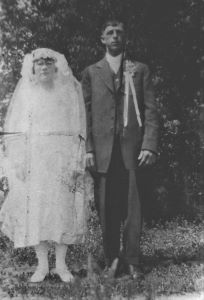
Dan Teichroeb and Maggie Schapansky on their wedding day.
The old farmhouse they lived in was on a half section of land 300 yards from the Canadian National Railway line. Peter and his older sister Erna were born on that farm. Pete’s other siblings were all born at the hospital in Warman. The house was a comfortable two-bedroom frame structure with a separate kitchen and living room. There was no plumbing or electricity, but the walls were plastered and painted or papered and the wooden floors were painted.
In the yard was a well that supplied drinking water and a cistern for collecting the rainwater used for laundry. In the farmyard there was a barn that housed four horses used for farming, four cows, a pig, and chickens. About two thirds of the land was seeded with wheat and oats.
The closest neighbors were the Waldners. The two neighbor ladies, Mrs. Waldner and Margaret, became good friends and visited each other often, wearing a quarter mile long path through the field between their houses.
People who know Pete are aware that he has a keen analytical mind and an intuitive, hands-on approach to solving technical problems. As early as 1932 a three-year-old Pete first displayed this rapidly developing skill. He was helping Dan clean the seed drill. Dan instructed him to keep his hands clear of any moving parts but Pete, always one to roll up his sleeves and help where he could, stuck his finger in the auger as Dan was turning the wheel. The blade caught his finger and lopped off the fingertip. Pete did not make a sound, but just walked away streaming blood. Across the yard Margaret noticed his strange behavior and, running over to check on him, discovered the injury. First aid was quickly administered but Pete retains this physical symbol of his emerging technical prowess to this day.
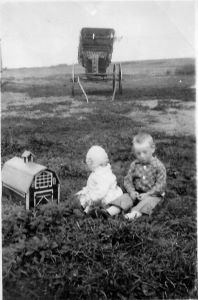
Pete, not long after the seed drill incident
A year later, in 1933, the family rented a farm east of there, farther from Saskatoon and about half a mile from the South Saskatchewan River. This farm had a larger barn and more land to raise more cattle. They also raised more horses, eventually keeping a herd of ten. Dan possessed expertise in breaking horses and broke all his own animals.
The country roads in those days were not graded highways. Rather they were horse and buggy trails following the marker stakes laid out by surveyors to map out what would later be the straight grid roads that span the province today. The road between Laird and Waldheim, around where Marjorie lived, was this kind of trail. In farming communities each municipality, comprised of thirty-six sections, was responsible for its roads. The municipality would hire local citizens to work on the roads in exchange for cash wages or a tax receipt exempting the recipient from that amount of future taxes. In towns and villages, such as Warman, the town was responsible for its roads. Whereas country roads were nothing more than wagon trails the roads in towns were typically gravel, with paved main streets as time went on. By the time Pete left the farm the roads were graded, although still not raised highways.
It was not until 1938 that Dan’s Naturalization became official. Until then the family had regular visits from the RCMP, who were charged with keeping tabs on landed immigrants. Peter’s desire to join the RCMP was inspired by these frequent visits. In these meetings the two officers would chat with Dan, and Margaret would always attend to help translate because Dan’s English was not fluent.
In 1939 the family moved again to another rented farm three miles west of Martensville and four miles south of Dalmeny. Each move brought them a larger farming operation.
Finally in 1943 Dan and Margaret bought a farm of their own three miles to the south. This farm was on a much larger scale than anything they had worked before. It had separate barns for horses and cows. In 1946 they started a dairy farm with a proper dairy barn featuring concrete gutters and whitewashed walls. It was capable of housing 16 cows. Milking was done by hand, with a bucket, usually by Dan, Margaret, and Pete. Margaret was the most expert and could easily milk twice as fast as the others.
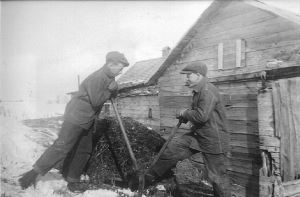
Pete (on the right) and his brother Louis on the farm in the '40s.
Pete recalls a winter day in 1947 when Dan and Margaret drove to Saskatoon for supplies and got snowed in. By now the farmhouse had a telephone and Dan called Pete to remind him to milk the cows. The herd by now had grown to 12 cows and Pete was left to milk them all. This experience may have influenced his decision to not take up farming in later years.
All the farmhouses the family lived in were like that first house where Pete was born. There was neither electricity nor plumbing in any. Wells supplied drinking water. Kerosene lamps and Aladdin lamps were used for interior lighting. Typically, there were cisterns for collecting rainwater for laundry. Floors were of painted wood. When they could afford it, they would install linoleum on the floors and wallpaper on the walls.
The main source of income for the family was farm produce. Grain would be harvested and taken to the local elevator for sale. When they operated the dairy farm, they would ship milk and cream in cans to the nearest railway terminal from which it would be transported to the commercial dairies in Saskatoon. In later years, the commercial dairies would travel the countryside picking up the milk and cream at each farm. In some years the family would raise a couple of steers and when these went to market, they received very good income. Usually, they raised several pigs and in autumn when the pigs had reached market weight (200 pounds) they would go to market. Maggie worked at home and did not earn a cash income. She sewed all the dresses for the girls. She also crocheted.
One steer was butchered every autumn, even during the war, for the meat and hide. Hides were important for making shoes and were sold to a tannery in Saskatoon. Butchering a steer was not quite the extravaganza that pig butchering was because there was no sausage making and smoking. It was a more straight-forward task of skinning the animal and cutting up the meat.
Dan did occasional work for the municipality to complement the farm income. In addition, Dan held jobs transporting children to school. He could earn $30 a month driving the children to Warman in the winter with a covered sleigh and team of horses. In warmer weather he used a wagon and team.
Dan and Margaret always lived in the Warman area and there were many Schapansky aunts and uncles living close by, around four to eight miles away. Margaret’s sister Lena and her husband Abe Penner farmed the land that Wanuskewin Heritage Park is located on today. The Teichroebs, on the other hand, lived in the Carleton area where homesteads were being offered at the time they immigrated.
By the time Peter was a youngster the Schapansky grandparents had also moved to the Warman area. He was very fond of these grandparents. He recalls that his grandmother, Maria, was quite stout and did not move around very much. He never knew who did all the work to prepare for big family gatherings, but the family got together frequently. Since they lived close by, frequent visits were very easy, and there were lots of Schapansky cousins living nearby to spend time with. Two of these cousins were the same age as Pete and when they got together during the holidays the boys would play games of hide-and-seek, baseball, football, and when they were bored, they would spook the neighbor’s pigs by sending the dog after them. This last sport usually got the boys into a lot of trouble. After that they would go out into the cattle pen and ride the steers. Usually, they were thrown off to land in the manure.
Christmas was a time for family gatherings. On Christmas Eve the children left out an empty plate and on Christmas morning they found a plate full of treats and a Christmas gift – one gift per child. There was lots of baking and homemade candy to eat. The Schapansky grandparents would have the entire extended family together for Christmas dinner. Christmas dinner in those days was roast beef, not turkey. The adults ate first, and they were followed by the children. After dinner everyone cracked and ate nuts. The shells were scattered all over the floor. Grandma Schapansky would sweep up periodically and then everyone would start again.
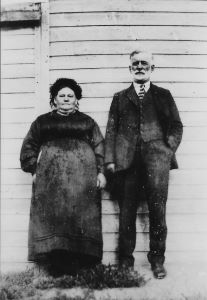
Grandparents David and Maria Schapansky.
Pete’s grandfather Peter Teichroeb was an old man when Pete remembers him. He was born in Schoenhorst, Chortitza in 1857. In his old age he moved from one child’s farm to another to live. Whereas he had been wealthy in Russia, he had no money when he lived in Canada, and most of his children were not keen to put him up. In addition, he had some health issues that were difficult to deal with. When Pete was about six or seven years old his grandfather came to live with them for a whole year. Then he moved out to Garthland to live with two of his daughters. Pete remembers going out to visit his grandfather in Garthland one time, in a horse and buggy. The trip took three days each way. Later they would use a car and the trip was much quicker.
The Teichroeb and Schapansky grandparents all spoke Low German. This increasingly rare dialect was once widely spoken, as far back as the 15th century or earlier, by citizens of members of the Hanseatic League. Although the Dutch Mennonites abandoned the use of Dutch in Church services in the late 1700s, they were able to preserve the Low German language. The Schapansky uncles and aunts were educated in English schools and were, of course bilingual. Dan Teichroeb came to Canada speaking fluent Low German, Ukrainian and some Russian. He picked up English over the years.
Peter and his family went to church in Warman about once a month when he was a youngster. In 1940 the family bought a 1929 Chevy and then they went to church weekly during the summer. Peter recalls that this car had to be held in high gear with a stick or it would pop out into neutral.
Operating a dairy farm is a difficult way of life and making ends meet is harder still. In 1948 Pete moved to another farm in Dinsmore to work and brought all his wages home. This amounted to $900, and it was used to buy a tractor – a red and yellow 1944 Cockshutt 70 “screaming demon” with a six-cylinder engine. Then in 1949 he moved to Saskatoon to get off the farm. He still came home in the Spring to help put the crops in. By 1951 Dan was tired of sixteen-hour days and the constant demands of the dairy. Since Pete was not interested in farming, they sold the farm and moved to Saskatoon.
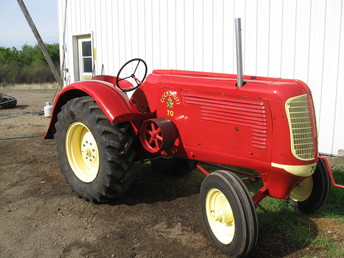
1944 Cockshutt 70 - www.tractorshed.com.
Pete began working in Saskatoon in 1949 while his parents still had the farm. He first lived at a boarding house with seven other boarders. He lived in a simple room on the third floor with enough space for a bed and a dresser. The landlady cooked for the boarders and took care of the cleaning and laundering of bedding. The landlord was Pat Fast, cousin to Albert Fast and great grandfather of Daniel McElligott’s wife Chelsea LaVallie. Daniel is Pete’s grandson.
Pete’s first job in Saskatoon was as a butter maker at the Dairy Pool in Saskatoon. He moved to Swift, the meat packing firm, during the Christmas season to feed turkeys. Following that he worked at a Dodge dealer as a car jockey and car washer. He was there for only a couple of months before he joined Saskatoon Motor Products as a mechanic’s assistant.
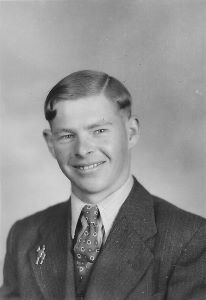
Pete in Saskatoon, 1950.
He signed up for an apprenticeship and his employers sent him to trade school. The school was in the old army barracks on 33rd Street. He attended school for a three-month term every year for four years and completed his apprenticeship in 1955. For a short period, he moved to Rosthern to work as a mechanic when all employees at Saskatoon Motor Products were laid off to defeat a union certification attempt. He was called back after the union was successfully decertified.
Pete has always loved cars and therefore it is essential to touch on some of the vehicles he owned in the early years. His first car was a black 1929 Model A Ford. It was a two-door sedan with a back seat (coupes had two seats and a rumble seat that folder out of the trunk), a self-starter, and wire wheels. Next, he bought a 1941 Dodge, a black four door sedan. Then he bought a black 1949 Chevy Torpedo-back four door sedan. He did not have this car long because it was destroyed in an accident, being hit by another car, and then smashing into a tree. Pete replaced it with a black 1951 Chevy four-door sedan. This car was fully loaded, complete with an automatic transmission, a radio, signal lights and a heater! In 1954 when Marj and Pete were married they bought a new 1954 Chevy two-door for $2,100. It was light green with a white top.
Post a comment